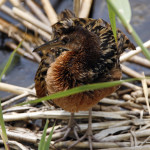• • •
King Rails are shy and usually found in the dense vegetation of freshwater marshes, where their colors blend in with the background. You’re more likely to hear them than see them. The phrase “thin as a rail” comes from their narrow bodies, which enable them to slip quickly between the reeds and grasses without creating a disturbance that would give them away to predators.
• Length: 15 inches
• Wingspan: 20 inches
• Season: Year-round
More about King Rails.
Where they are, and when.
They are similar to the Virginia Rail, but much larger and with darker cheeks. The barring on their belly is more distinct than on the Gulf Coast Clapper Rail, which favors saltwater marshes.
King Rail and their cousins feed in shallow water and mudflats on small fish, insects and crustaceans. They’re more likley to swim or dart across open areas of the marsh than fly.
With its camouflage and stealthy habits, the King Rail depends on distinctive calls rather than sight to mark its territory and locate a mate. In courtship, the male struts around his prospective partner with his white undertail puffed out.
To build a nest, the birds assemble a platform of grass and reeds and pull nearby grasses over the top to create a canopy. They may lay as many as a dozen buff, spotted eggs and often will replace those that fall victim to predators. The chicks are able to swim and forage for themselves not long after hatching, though their parents may feed them at the outset.
April 21, 2008
I came upon a King Rail inadvertently just off the boardwalk of Shoveler’s Pond at the Anahuac National Wildlife Refuge. It had nestled in a small opening of water deep in the reeds and was giving itself a bath by rolling vigorously on the top of the water. The muffled splashing of the water gave the only clue it was there. With it’s feathers puffed up to dry and its tail fanned out, it resembled a small wild turkey. Its bath done, it stood almost motionless in a staring contest with me that it easily won.






You must be logged in to post a comment.